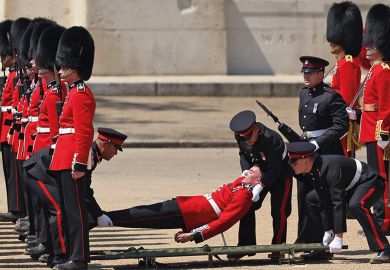Browse the full results of the World University Rankings 2025
It is the year of elections, with more than half of the world’s population going to the polls. The UK, Mexico and Pakistan are among the countries with new leaders, while the US is bound for a change in president next month.
A similar level of leadership churn has been under way in global higher education. Four of the top 10 universities in the Times Higher Education World University Rankings have appointed new vice-chancellors or presidents this year, while a further three institutions have leaders who have been at the helm only since last year.
The trend continues further down the table: 11 of the top 20 universities in the world have leaders who started in January 2023 or later.
The US, the UK and South Africa are among the nations that have had particularly high levels of leadership turnover in recent months.
Nine of the US’ top 20 institutions have presidents who have been in post for less than two years, while a further two institutions have confirmed their current presidents will be stepping down next year.
The recent departures include Elizabeth Magill, Claudine Gay and Baroness Shafik, who stepped down from the University of Pennsylvania, Harvard University and Columbia University, respectively, after being criticised over their appearances at congressional hearings on antisemitism, and Marc Tessier-Lavigne, who resigned from Stanford after months of internal investigations found he did not correct known errors in his published research articles.

An analysis by THE earlier this year found that at least one in five UK universities was set for a change in leadership in 2024. Several leaders quit this year after overseeing painful restructuring programmes. The country’s top two universities – Oxford and Cambridge – also gained new vice-chancellors last year.
Meanwhile, half of South Africa’s top eight universities (ranked in the global top 800) have had changes in leader since January 2023. Mamokgethi Phakeng was forced out of the University of Cape Town last year amid accusations of intimidation and mismanagement – later substantiated by an independent inquiry. Tawana Kupe also resigned suddenly from the University of Pretoria after being cleared of a sexual harassment allegation that was investigated by the institution.
While the reasons for the departures vary – with some leaving voluntarily and others being encouraged or asked to move on – one factor for the high rate of turnover is that many leaders stayed in post during and immediately after the pandemic, so the level of change is now more compressed than it would otherwise have been, says Richard Bolden, professor of leadership and management at the University of the West of England.
The challenges facing many higher education systems since Covid, “particularly around funding, financing and the associated restructuring” of institutions, might also provide an opportunity for leaders to “consider whether they want to carry on doing the job [or] move on more rapidly than they would have” otherwise, he adds.
One downside to having lots of new appointments at once, according to Bolden, is that “the availability and capacity of people to stand up and take leadership roles on behalf of the sector more widely – within their country and across countries – is going to be more challenging” as new leaders are likely to focus attention on their own institutional priorities.
Morton Schapiro, a professor of economics, was president of Northwestern University from 2009 to 2022, after leading Williams College for nine years. He says that leadership changes are “somewhat episodic. Sometimes you just have a whole bunch of long-term presidencies and they end pretty much at the same time.”
But he suggests that the current scale of turnover is also a symptom of the fact that “the world is changing” and “academe is not immune from all the pressures and challenges of the larger world”.
“Just look at the political upheaval in France, in England, the craziness of the election here in the US. That makes it very fraught on campuses. And then when you have international challenges like the Middle East, that enters campus, and you have people with very different views and pretty much impossible situations for a lot of presidents,” he says.
The latest leadership changes in the US are also reflective of a longer-term trend of shrinking tenures of university leaders. In 2022, presidents had been in the job for an average of 5.9 years, according to the latest American College President Study from the American Council on Education, down from 6.5 years in 2016 and 8.5 years in 2006.
Schapiro says that there is now “an impatience” with university leaders from boards of trustees and faculty, which means that few are given the opportunity to find their feet and overcome early challenges.
“Back in the old days, people would have rocky transitions in the beginning. Usually after that followed a very successful long-term presidency. And you would talk to them and they would say ‘the first couple of years were tough’,” he says.
“I’m not so sure you get that first couple of years any more. The trustees seem to be always looking for the next person; the faculty are very quick to do a vote of no confidence. So I think people who would have learned [the job], been better and really become better accepted within the community never get that opportunity…I don’t see boards in general [being] as supportive as they used to be.”
Schapiro’s view is that “most of these attempts to so-called trade up fail. And once you have a reputation that you have a board of trustees who are just rolling through one [leader] after another it becomes extremely disruptive for an institution.
“When you look at the numbers of people who are losing confidence in higher education, I think part of it is that every day they pick up the paper and there’s a new president at a very famous school,” he adds.
A nation that is especially accustomed to “the very intense politics of higher education” is South Africa, says Jonathan Jansen, distinguished professor of education at Stellenbosch University. But its leadership turmoil over the past two years has been dramatic even by its own standards.
“It wasn’t just the result of the usual turnaround [after] a five- or 10-year term. It was explosive,” says Jansen, who was vice-chancellor of the University of the Free State from 2009 to 2016.
“We had one incident after another of universities losing their vice-chancellors in a very public way. In a country with only 26 public universities, like South Africa, that becomes quite visible…and then that gives people a sense that all might not be well in the sector as a whole.”
Like Schapiro, Jansen is concerned about the disruption to institutions, as well as the potential slowing down of progress for South Africa’s universities. But he is “even more concerned” that the leadership “cupboard is bare”.
“There aren’t a whole lot of people who are capable and competent to be able to do the job of leading a complex organisation such as a university…And then what happens is the people who rise to the fore are the people who you don’t want to lead universities – they don’t have the breadth of experience, they don’t have the temperament, they don’t have the vision,” he says.
His view is that most of South Africa’s university leaders are “managers and administrators in the narrowest sense”.

“Can you imagine, in the context of Gaza and the Palestinian crisis, a more important role for a university leader in this time? Not a single one of our leaders in the 26 public universities has taken a stand [to say], ‘This is where we stand as a senate, this is where we stand as a university’,” he says.
“So you have people who put their heads down and say, ‘I’m just going to balance the budget, submit a future plan, monitor our outcomes and that’s what being a university leader is about’. Can you imagine anything more boring? That’s not a university.”
But Jansen is taking matters into his own hands. He recently convened a group of former vice-chancellors, government leaders and experts in the private sector – dubbed “university elders” – to find a solution to the leadership crisis. The working plan is a leadership training programme for heads of department, deans and deputy vice-chancellors who have the potential to become effective vice-chancellors in five, 10 or 15 years’ time. Each trainee would be assigned a mentor and the programme would “deal with the disciplines of administration and management” and “build their capacities to lead”.
“Very often the problems that vice-chancellors face are…of their own making,” Jansen says. “If you’re going to go in like a bull in a china shop and antagonise your senate, you’re dead in the water. If you don’t understand the importance of how to nurture relationships with big donors, you’re dead in the water. Those are skills that can be taught and I do believe it will make those people who want to do the job more confident and more willing to take it on.”
Jansen already runs a similar initiative for the government called the Future Professors Programme, focused on teaching young academics how to become professors. He hopes that by January the elders group will have a more detailed plan for the future leaders programme “for which I do think we will be able to get good funding”.
Bolden believes that a similar sector-wide initiative to develop leadership capacity at senior levels is necessary in the UK, too, given the “scale of the turnover”.
“A real challenge for the sector is encouraging, enabling and supporting those people who have the motivation and ability to step into leadership roles to do so,” he says.
“In many ways the attractiveness of those roles is not huge for people who might have options to do other things. And certainly there remains a question of how we diversify the population of leaders and the routes to those positions,” he says.
However, Bolden cautions against focusing too heavily on the single head in charge of a university – “a situation where we put too much expectation and demand on a single individual, hoping that they might be able to resolve our collective problems” – and “not enough on wider leadership capacity within the organisation and within the sector”.
“One of the ways you might mitigate a lot of change within particular role levels is to look at how we – the systems, the structures, the cultures – support and enable leadership at all levels rather than just at v-c level,” he says.
Some have raised fears that some would-be university leaders will be put off from applying for such roles, given the financial challenges, heightened political and public scrutiny and increased bureaucracy and regulation in many higher education systems.
However, Jansen says, while “a lot of people will opt out…there’s always a percentage of people in any context who actually do enjoy leadership. They just want to feel that they’re prepared for it, that they have support for it and that they go in with their eyes wide open.”
Schapiro agrees that the concern around a diminishing pool of willing candidates is “overblown”.
“I help with a number of searches and almost everybody I suggest, I call them up and they say ‘sure’. People have confidence and they think they can do it,” he says. “So I don’t really worry that a generation of new leaders will shy away from administration.”
He is also “optimistic” that the pendulum of university leadership will eventually swing back towards stability.
“There were times when it was really difficult to be a president and there were a number of short presidencies – that was certainly happening in this country in the 1960s until the early 1970s. And then stability was restored. I think when the world settles down, academe will settle down,” he says.
In the meantime, he believes that being a university president is still a “great job”.
“The amount of intellectual stimulation you get from being not just in your department, but really exposing yourself to a wide variety of disciplines. The joy you get from raising resources to support research, teaching and student activities that are transformative. That’s even more fun than publishing in a top journal in my experience. You really feel good that you’re moving things along, you’re empowering voices that don’t always get heard,” he says.
“These jobs are really great if you can compartmentalise and not worry about a small percentage of people who are always acting to get you removed.”
Register to continue
Why register?
- Registration is free and only takes a moment
- Once registered, you can read 3 articles a month
- Sign up for our newsletter
Subscribe
Or subscribe for unlimited access to:
- Unlimited access to news, views, insights & reviews
- Digital editions
- Digital access to THE’s university and college rankings analysis
Already registered or a current subscriber?








